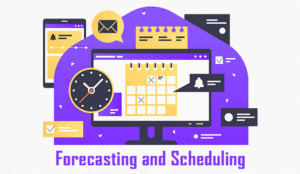Accurate forecasts are vitally important to a contact centre’s success, but with so many options available to create a forecast, what tips, tools and techniques should contact centre managers really be looking at to make this better?
Our panel of experts share their top tools, tips, and techniques to make contact centre forecasting as accurate and easy as possible.
12 Ways to Improve Your Contact Centre Forecasting
Here are 12 expert tips for doing your forecasting well:
1. Use the Right Evaluation Period
When evaluating forecast accuracy, remember that the evaluation period is important.
Analysing accuracy at a monthly or weekly level serves as a reasonable scorecard.
Analysing accuracy at a monthly or weekly level serves as a reasonable scorecard. However, it does little to help you to discover when the forecast was consistently over or under the actual demand.
Imagine a week during which your forecast total weekly volume is completely accurate but you underestimate the volume of offered calls by 2,000 for the first three hours each day and overestimate the number of calls by 2,000 during the last three hours each day.
The weekly accuracy score would be 100%, but you’d be suffering serious understaffing and overstaffing every day.
Ensure that you measure accuracy down to 15- or 30-minute interval levels to avoid compensating errors. Use a proven method such as Mean Absolute Percent Error (MAPE) to produce an aggregate accuracy score covering multiple intervals.
Contributed by: Chris Dealy at injixo
2. Remember It Requires Refinement Over Time

Forecasting is an iterative process that requires refinement over time. By combining historical data analysis, advanced tools, and collaboration, contact centre managers can make forecasting more accurate and manageable.
Gathering historical data around call volumes, chat interactions, and email enquiries will make it a simple task to work around seasonal peaks and trends.
WFM and WFM tools can then be deployed to utilize their many algorithms and machine learning can be used to provide predictive models that consider multiple factors to make the task of forecasting a simple one.
Contributed by: Chris Angus at 8×8
3. Understand the “Why” Behind the “What” of Operations
Resource planning is far more than a behind-the-scenes operational process. When supported by the right technology, it is a powerful business tool.
Modern workforce engagement management (WEM) solutions offer agile scheduling and forecasting functionality that serves the complexities of today’s hybrid, multiskilled workforce in omnichannel contact centre environments.
Consider blending WEM with integrated quality management and analytics to further analyse operational issues, identify root causes, and drive relevant changes.
For example, giving supervisors predictive analytics and advanced reporting enables improved planning and forecasting while boosting performance and wider workforce engagement.
These tools help contact centre leaders to understand the “why” behind the “what” of operations to create meaningful schedules and forecasts.
A bonus is that this shows that an organization is listening to and caring for its employees, while meeting important customer SLAs.
Consider blending WEM with integrated quality management and analytics to further analyse operational issues, identify root causes, and drive relevant changes. Combined, these will guide and impact the effectiveness of your contact centre forecasting.
Contributed by: Nick Brook at Calabrio
4. Don’t Rely on Conventional Solutions for Digital Channels

Contact centre forecasting has become challenging with the explosion of new digital channels.
Employees are now not only answering calls but also asynchronous work items, such as email, chat, social channels, and back-office tickets, which can be intermittent and last longer than the planning interval.
Conventional forecasting solutions can’t take this into account, whereas a modern WFM solution coupled with advanced analytics can.
This solution deconstructs work items into the activities that occur in each interval. The amount of time an employee spent on a contact is reported in the interval in which it occurred, for an accurate representation of what happens within each interval.
This requires deconstructing contacts to the interval in which work occurred, then counting the contact when it arrives and again in the intervals in which the contact is being worked or is active.
This approach generates a more accurate reflection of how much time is spent and when an employee is working on something, thus enabling improved forecasting.
Contributed by: Andrea Matsuda at NICE
5. Review and Update Forecasts Based on Historical Data

Rising customer expectations and hybrid working models conspire to make forecasting trickier than ever before. However, the answer is simple if you get back to basics.
Archive all forecasts but remember to review them regularly. Just like demand, forecasts change constantly, so set a regular date, at least once a month, to review and update forecasts based on historical data.
Consider revisiting Triple Exponential Smoothing, still a forecasting stalwart in many contact centres.
Fortunately, modern automated solutions make light work of the process, being jam-packed with hundreds of algorithms which organizations can test, using historical data, in an instant. What is more, every 15 minutes, these forecasts update automatically.
Close the loop with artificial intelligence (AI) that recognizes patterns through deep learning in the same way that traditional WFM solutions access historic data to predict, create, and model future forecasts. Harness AI to keep one step ahead, delivering the right-sized resources to the right place at the right time.
Contributed by: Nick Brook at Calabrio
6. Choose the Right Data
Capture the volume of offered contacts, not handled contacts. Forecasts should be based on contacts initiated by customers, not contacts handled by your employees. Handled contacts exclude abandoned contacts, which you should include in your estimate of demand.
Omit ‘short abandons’ from the count of offered calls. Short abandons are calls that have entered your system but are terminated by the customer within a few seconds.
Contributed by: Chris Dealy at injixo
7. Factor in How Interactions Vary Across Channels

Make history your ally! Delve into past data to unearth valuable trends and patterns that can guide your future projections.
Equally crucial, embrace the power of advanced forecasting tools that incorporate algorithmic capabilities. These tools are akin to having an experienced navigator by your side, steering you towards accurate predictions.
Now, when it comes to different communication channels, each has its own unique story to tell. Factor in how customer interactions vary across these channels to ensure a more accurate forecast.
Lastly, tap into the knowledge of your frontline staff. Their hands-on experience often reveals insights that data alone might not capture.
By weaving these strategies together – leveraging historical data, adopting sophisticated tools, considering multichannel dynamics, and involving your team – you can significantly refine the precision and ease of your contact centre forecasting.
Contributed by: Ben Booth at MaxContact
8. Choose Your Forecasting Algorithm Carefully

A proven, well-understood method is linear regression. With some ingenuity, this method can be implemented in Excel.
More sophisticated algorithms exist, e.g. triple exponential smoothing, auto-regressive integrated moving averages (ARIMA), neural networks, and multiple temporal aggregation.
Realistically, these can’t be implemented in a spreadsheet. A good WFM application will not only offer an array of powerful forecasting algorithms like these, but it will also learn which algorithms deliver the best results with your data.
This is made possible by machine learning, a subset of artificial intelligence (AI). AI will continue learning as new historical data is collected and therefore constantly improve accuracy.
The best bit: a good WFM application will do this with almost no manual intervention. You get the sort of accuracy that previously required a PhD in maths while dramatically reducing the effort required to produce forecasts.
Contributed by: Chris Dealy at injixo
9. Understand Where Adjustments May Be Necessary

Inaccurate forecasts can lead to significant understaffing or overstaffing. Understaffing causes long wait times, which frustrates customers and stresses agents, while overstaffing can cause poorly engaged agents and paying for more staff than needed. Both impact your business’s bottom line.
The right workforce management (WFM) solution can ensure that your contact centre is properly staffed. Using historical data, WFM predicts accurate contact volumes and generates schedules to match agent resources with demand.
During the day, WFM compares forecasts with actual volumes to let you know when and where adjustments may be necessary.
Contributed by: Craig Lewis at Five9
10. Always Keep an Archive
When forecasting, you should never overwrite the original data. You need to be able to ‘undo’ any changes in case you make a mistake or an incorrect assumption. That’s why it’s important to keep an archive.
Contributed by: Chris Dealy at injixo
11. Elevate the Role of the Resource Planner and Update Your Job Spec
As scheduling and forecasting takes centre stage, the importance of resource planners has grown exponentially, but so has the job spec!
Supplement traditional planning expertise and Excel genius with a new set of skills including:
- Thinking Strategically – Help the business to understand how effective scheduling and forecasting can best serve corporate vision, company values, brand image, and the bottom line.
- Transforming Operational Planning – With creative yet achievable long-term forecasting plans that consider recruitment and attrition models, as well as training and upskilling programmes.
- Curiosity – A keen researcher delves into the drivers behind demand and communicates their findings confidently.
- Good Staff Engagement – Inventive and insightful. Constantly looking for ways that time can be allocated to drive colleague engagement, enrichment, and retention.
- Super-Proactive with Tech – Ready the business ahead of the day with a series of short-term, ‘what-if’ forecasts and plans that help the contact centre prepare for the madness of ‘on-the-day’ management.
Contributed by: Nick Brook at Calabrio
12. Get the Five Key Steps Right
Whether the tool you use for forecasting is a WFM application, a spreadsheet, or Post-It Notes, there are 5 steps to successful forecasting:
- Collecting historical data
- Gathering business intelligence
- Validating the data
- Creating volume & AHT forecasts
- Evaluating forecast accuracy
If you fail to give any one of them the attention it deserves, you will always struggle to create accurate forecasts.
Ensure that the technology you choose covers all these bases well. Number 4 – generating the forecast – gets the headlines, but integrations to collect data, functionality to validate the data, and the ability to factor in business intelligence and evaluate accuracy are just as important.
Contributed by: Chris Dealy at injixo
For more great insights and advice from our panel of experts, read these articles next:
- 15 Ways Contact Centre Technology Can Help Address Inefficiencies
- How to Improve Your Contact Centre Reporting
- 17 Signs Your Contact Centre Technology Is Ageing Badly
- What to Include in a Business Case for New Technology
- How to Measure Chatbot Performance
Author: Robyn Coppell
Reviewed by: Jonty Pearce
Published On: 2nd Oct 2023 - Last modified: 13th Aug 2025
Read more about - Workforce Planning, 8x8, Andrea Matsuda, Ben Booth, Calabrio, Chris Angus, Chris Dealy, Craig Lewis, Editor's Picks, Five9, Forecasting, MaxContact, NiCE, Nick Brook, Peopleware, Scheduling, Workforce Management (WFM), Workforce Planning








































